Canon Rangefinder 85mm Lenses
A Description of Canon Rangefinder 85mm Lenses produced 1948-1975
Introduction of the Serenar 8.5cm f2.0 lens
In January-February 1948, Canon released the Serenar 8.5cm f2.0 lens which, with its portrait or short telephoto focal length and large aperture, was an important innovation by Canon. This design was of 6 elements in 4 groups.
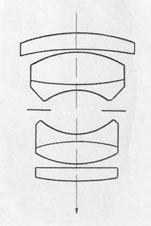
The new lens was presented in a fitted leather case with 8.5cm finder and a 50mm diameter series VII slide-on lens hood. The filter size was 48mm and the minimum aperture was f16. The next year, this lens became the 85mm f2.0 as Canon adopted millimeter markings.
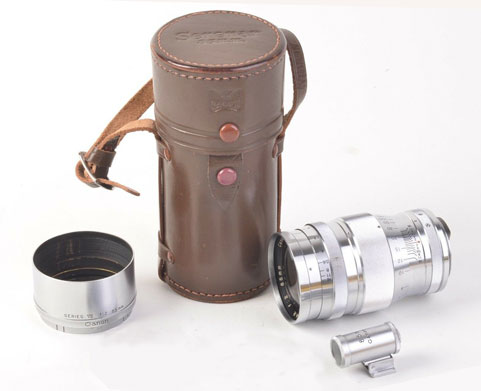
a 1951 Canon 85mm f2.0 with case and series VII slip-on lens hood
Canon even took great care to instruct the new photographer as to how to store the 85mm lens and its accessories in the fitted leather case
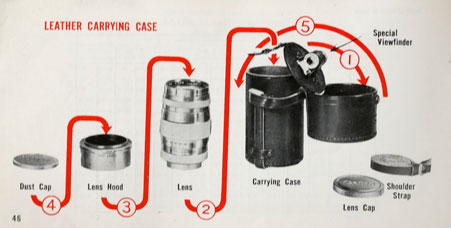
The month before, in January 1948, Canon had also introduced its 100mm f4.0 medium telephoto lens. Although the 100mm was visually much smaller, the 85mm lens with its wide aperture lens was not that much heavier: 570 grams versus 450 grams for the 100mm f4.0 in a chrome finished brass mount. 2
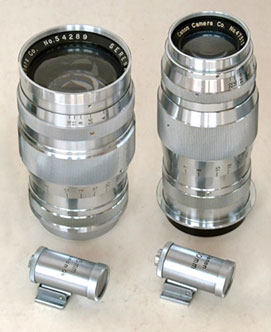
(l) Canon 85mm f2.0 compared with (r) Canon 100mm f4.0
Sales of the Canon 85mm f2.0
After Canon released the slightly faster 85mm f1.9 lens in August 1951 4, sales of the 85mm f2.0 were greatly reduced, although Canon continued to sell the f2.0 for a further 9 months. The continued sales are particularly surprising since they had virtually the same price - the older, smaller aperture lens sold for 29,500 Yen, compared with 30,000 Yen for the new lens.
Total sales of the 85mm f2.0 during a 4 1/2 year period were a respectable 9,005 - a majority through the military Post Exchange system. 2
Introduction of the new Serenar 85mm f1.9 lens
The new, slightly faster 85mm f1.9 was introduced in August 1951. Its appearance and size was markedly similar to its predecessor.
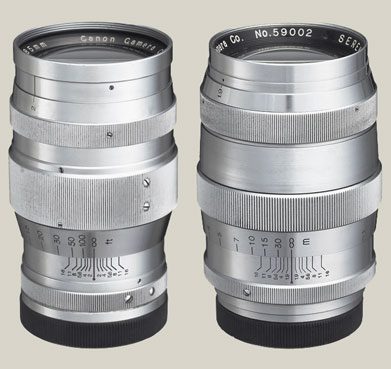
(l) Canon 85mm f2.0 (r) Canon 85mm f1.9
The Canon 85mm f1.9 lens design was of 6 elements in 2 groups.

In its orignal version, the 85mm f1.9 took a 48mm filter and a Series VII slip on hood. However, in June 1958, Canon completely revised the 85mm f1.9 in a new stronger, lighter alloy barrel with the new black finish adopted for its re-engineer range of lenses.
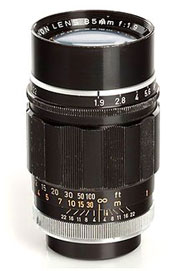
Canon 85mm f1.9 in black finish
Canon 85mm f1.5 lens
In June 1952, Canon released a very fast 85mm f1.5 lens. This lens was not only large, but quite heavy: 730 grams, compared with 605 grams for the 85mm f1.9. 4 It consisted of 7 elements in a group of 4 and a group of 3, compared with the 6 element 85mm f1.9. In its first year, 1952 was in a satin chrome finish, which was changed in 1953 to black f-stop and focusing rings, as shown in the photograph below. The 85mm f1.5 remained in that finish until manufacture ended in the summer of 1960. 2
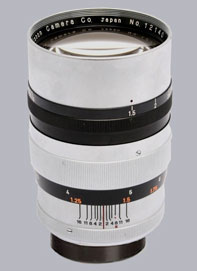
a Canon 85mm f1.5 of about 1958
The very large hood of the 85mm f1.5 - 78mm in diameter - had openings or 'vents' between the lens barrel and the outer ring of the hood to allow the photographer to see through this huge hood.
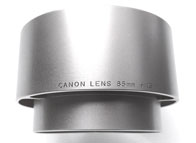
a Canon 85mm f1.5 hood
For filters, the lens used a 58mm screw-in adaptor ring into which filters could be inserted. The design of the lens was of 7 elements in 4 groups.
Success of the Canon 85mm f1.5 lens
The Canon 85mm f1.5 was manufactured from the summer of 1952 to the summer of 1960. Although regularly featured in catalogues and advertising, the lens sold only 1,336 units. 2
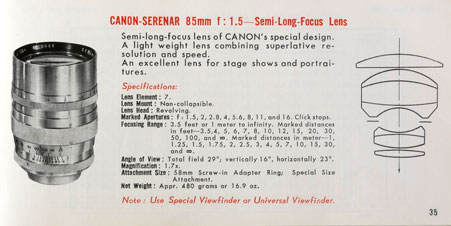
According to Peter Kitchingman 2, 137 Serenar 85mm f1.5's were produced in 1952 and 1,199 Canon 85mm f1.5's were produced 1953 to July 1960 - a total of 1,336.
Introduction of the Canon 85mm f1.8 lens
The Canon 85mm f1.8, introduced in March 1961 at the time of the Canon 7 camera was a late arrival into the Canon rangefinder lens line. But it was also an impressive arrival, in its size, in its weight (only 470 grams), and above all in its image quality, still admired today.
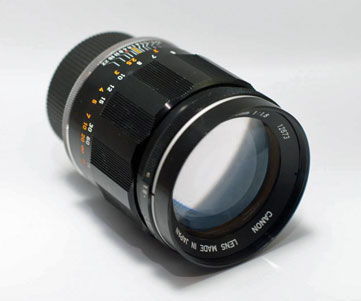
A late release Canon 85mm f1.8 of 1973
This lens was a 5 element in 4 groups design which earned a reputation for its quality.
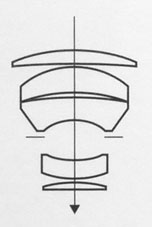
During its availability 1961 to 1975, the Canon 85mm f1.8 continued to be a favorite among professional photographers for its excellent qualities. The wide aperture in a 85mm focal length was effective for portraits, fashion photography, and available light photography at live events. This caused Canon to continue its distribution until its termination of M39 rangefinder lenses in 1975. Its popularity was focused primarily to professionals and consequently, during 1961 to 1975, sales were relatively slight: 2,951 units. 2
85mm Lenses in the Canon range
As can be seen in the sequence of Canon 85mm lens innovations from 1948 until the end of Canon rangefinder lens production on 1975. the 85mm focal length was an important part of the ever growing attractivity of Canon lenses. Click on the links below to read about other Canon lenses in the canonrangefinder.org site.

chromium finish Canon 85mm f1.9 on a Canon P rangefinder
You can click on the links in the table below to consult other pages of the canonrangfinder.org site.
| Navigation: Click Below to Jump to Desired Subject Page | ||
|---|---|---|
| Canon Rangefinder Cameras - 1 | Canon Rangefinder Cameras - 2 | Canon Rangefinder Lenses |
| Canon S | Canon IVSB2 | Canon 19mm |
| Canon J | Canon IIS2, IID2, IIF2 | Canon 25mm |
| Canon NS | Canon VT, Canon L2 | Canon 28mm |
| Canon JS | Canon L1, L3 | Canon 35mm |
| Canon J-II | Canon VT Deluxe | Nikkor 50mm |
| Canon S-II | Canon VL, VL2 | Canon 50mm |
| Canon IIB | Canon VI-L, VI-T | Canon 85mm |
| Canon III, IIC, IV | Canon P | Canon 100mm |
| Canon IIIA, IVF, IVS | Canon 7 | Canon 135mm |
| Canon IIA, IID, IID1 | Canon 7s | Canon 200mm-1000mm |
| Canon IVSB | Minolta Rangefinders | Minolta Lenses |
| Canon IIF, IIS | Other Rangefinders | other M39 lenses |
| Go to canonrangefinder.com home page | ||
Any additions or corrections to these pages would be welcome simply by contacting this site as shown at the foot of this page .
Footnotes:
1 Dechert, Peter. Canon Rangefinder Cameras 1933-1968. Hove Collectors Books. West Sussex, United Kingdom. 1985. ISBN 0-906447-30-5.
Peter Dechert's book is the most important expert source of information regarding Canon Rangefinder Cameras.
2 Kitchingman, Peter. Canon M39 Rangefinder Lenses 1939-1971. A Collector's Guide. Published by Peter Kitchingman. Perth, Australia. 2008. ISBN 978-0-646-48144-9.
Peter Kitchingman's book is the definitive study of the more than three decades of M39 format camera lenses developed for Canon Rangefinder Cameras.
3 Nostalgic Canon Camera Book. 懐かしいキヤノン EI Publishing Co. Ltd. Tokyo, Japan. June 2003.
Peter Kitchingman's book is the definitive study of the more than three decades of M39 format camera lenses developed for Canon Rangefinder Cameras.
4 "Canon Camera Museum" history website. https://global.canon/en/c-museum/history/ published by Canon, Inc. accessed in 2019.
5 Rajner, Hans P. (author), John Wade (editor). Leica Copies. Classic Collections Publications. London, UK. ISBN 13: 9781874485056
Hans P. Rajner's book is an excellently detailed and carefully researched study of camera from around the world which used the Leica M39 lens mount and the same lens to film plane distance.
7 Dechert, Peter. Canon Single Lens Reflex Cameras 1959-1991. Historical Camera Publications. Yakima, Washington. 1992. ISBN 1-879561-04-2.
8 Tomlinson, Shawn M. The Film Photography Book. Lulu Pulbications. 2016. ISBN: 9781365263972
9 Sartorius, Ghester. Identifying Leica Lenses. Classic Camera 19. Tokyo, Japan. 2001. ISBN 4-257-12029-0
10 website http://www.nicovandijk.net/rflensmatrix.htm consulted 2019.
11 O'Reagan, Douglas M. Allied Exploitation of German Science after World War II. Johns Hopkins University Press. Baltimore, Maryland. 2019. ISBN 9781421428888
12 website www.canonrangefinder.servehttp.com consulted 2008.
13 Minolta expert Andrea Aprà has posted information on minoltarangefinders group and other groups and further detailed information by email. (thanks Andrea !)
14 website http://www.collection-appareils.fr/objectifs/ consulted 2019.
15 Small, Marc James. Non-Leitz Leica Thread-Mount Lenses. Wittig Books. Hückelhoven, Germany. 1997. ISBN 3-930359-47-2.
16 the Nikon Corporation website: https://imaging.nikon.com/history/ consulted 2019.
17 p 152. Ray, Sidney F. Photographic Lens ISBN 9780240510323
18 website http://www.rokkorfiles.com/Lens%20History.html accessed 2019
If you have any comments or questions about this Canon Rangefinder site, please e-mail me (Larry Huffman) at e-mail address: [email protected]